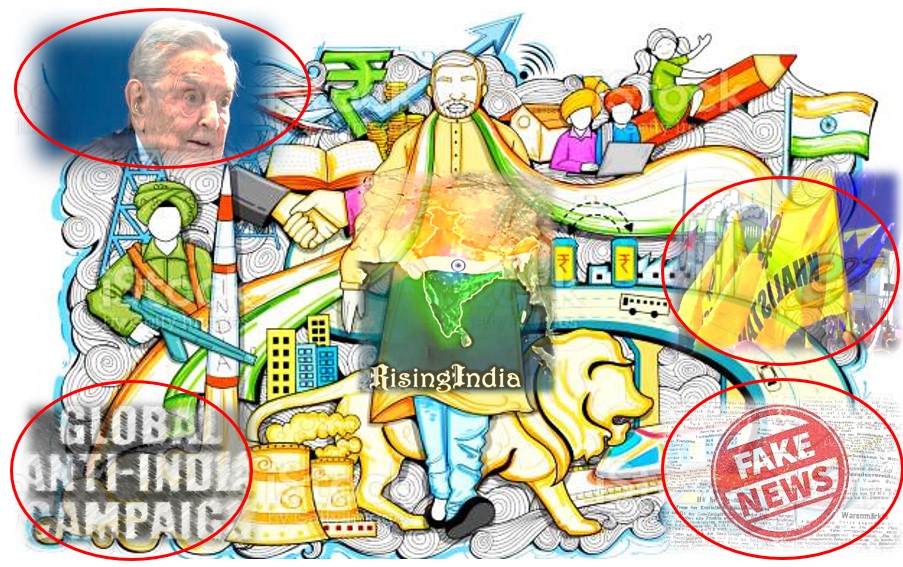
India Under Attack
 Sat, 01 Apr 2023
| Reading Time: 6 minutes
Sat, 01 Apr 2023
| Reading Time: 6 minutes

Threats as commonly understood in India have usually been those arising from China, Pakistan, and terrorism as the main ones. But there is another threat that has been brewing nearly 10 years and is now easily visible.
Indians regularly show fashionable curiosity about the quadrennial jamboree that our friends hold in America for their presidential elections. Many of our intellectuals spend hours analysing implications for their drawing room followers; North Americans pay little or no attention to what wise Orientals have to say about them. They are just so full of themselves.
It is the West that is now showing considerable interest in the Indian elections that will take place in the summer of 2024. Only that interest is not benign; it is visibly hostile, well-coordinated across think tanks, media anti-Indian elements living in their countries and mostly their citizens, raising religious issues as well as alleging discrimination by a Hindu majority. All false and inaccurate. This is symbolised by some arrogant sinister prognostication by a billionaire philanthropist with limited and selected interest. His declared primary goal is to have in India less Narendra Modi. This is not an ideological or noble call for democracy.
The West sees three major economic powers in Asia – Japan, China and India rising and the balance of power shifting eastwards. It is really about protecting and promoting the West’s vast commercial and global strategic interests which are under some peril with the present uncertainties. This would be in gross violation of the Western Rules Based Order. Therefore, today India is caught in a situation where its democracy and its desire to protect its national interests led by a leader who has shown determination to further Indian interests is seen as a threat by the West, by China, and by Islamists. This is the real reason; others are part of the narrative being churned out now.
The West seems to have a points person for this Great Operation, more like an intelligence operation to subvert the opposition. This man, George Soros, has often spoken darkly about India. He is entitled to his views and as we are about him. This narrative has been in the making for some years now; probably started in 2014 but gathered momentum after 2019. A presumed one-election wonder was making a habit of winning elections and had to be stopped. This was a serious venture, with no holds barred, short of a military invasion.
The US government sends a signal in the appointment of its new Ambassador to India after keeping the post vacant for two years. Judging from the Ambassador-designate’ s views on India it would seem that there are two messages – Washington agrees with these views, and they don’t care about Indian sensitivities, supposedly a friendly democratic country. The BBC’s documentary aired on January 17, 2023, about Narendra Modi and the Gujarat riots, was an example of creating negative narratives. Disinformation and narrative building have become the chosen route.
There is need for India to react – in the short term and act pre-emptively in the long term, that is tactical responses to wild stories about India. And strategically to sell our own story in advance for the future. India’s main problem is the lack of global communication facilities. All these – traditional and the new social media are controlled by the West. There are however several avenues that can be explored. Reactions in anger or emotional reactions especially by the Government make little difference; in fact, they are taken as a confirmation of the original statement or comment. All reactions need not be by the Government, but all reactions must be embellished by facts. Think tanks, mostly in the United States are usually well-endowed financially with big-name expertise, interface with other similar think tanks. They interact with the White House, the State Department and the Pentagon, the US government, the corporate sector, including the politically powerful military industrial complex of the corporate world which now includes technology and intelligence. Many of these think tanks have their outreach in other countries essentially following their own schools of thought while proclaiming independence of thought. The attempt is to provide long term narratives on the target country about its domestic politics its economic system and even geopolitics. Often, statistics are managed and manipulated to provide desired results. The recent Happiness Index may be laughable in India but there are enough people in the West eager to buy this line. The finding that India has less freedom than Afghanistan, Libya, Iraq, and Somalia is an absurdity and clearly indicates a massive manipulation of data.
India will have to improve the quantity and digital reach as well as the quality of research literature produced by Indian think tanks. Taking a leaf from how the foreign think tanks work Indian think tanks should begin to concentrate on the domestic political landscape in the US, selected European countries and a host of other nations. The picture that normally emerges is not as rosy as is made out; there is acute poverty, deprivation, discrimination, race conflicts and many more such social problems there are normally swept under the carpet. Private think tanks could then produce detailed rankings and reports on the political economic security, social and religious conditions of each country. Government of India could produce a comprehensive international religious freedom report like the US state department does. This would provide enough material for discussions over months in seminars and workshops, involving experts from the countries concerned.
Social media information warfare will continue to grow. Platforms like Twitter, Facebook and others pay greater attention to managing disinformation in the US and Europe than they do in India. This is not going to be easy to handle but the government could ensure that the Digital India Bill gives it adequate far-reaching capabilities to monitor and if necessary, block social media contacts and messages that can lead to significant disturbance in law and order. This would mean that data would have to be stored on Indian servers. Undoubtedly there will be an outcry about freedoms, but it is best to assert that India comes first.
New, foreign, and supposedly independent media outlets, backed by foundations and NGOs can create fast moving sensationalist high impact content. This is part of the entire exercise to keep India off balance. To counter this there would be a need to increase the frequency and depth of reporting requirements for foreign funded media groups and given the spate of transgressions of FCRA in recent times, this could be justified.
Various activist groups would be used to obstruct development activity, new projects, critical infrastructure development like dams, mines, ports, border roads highways. The delay in the completion of the Narmada dam and the Kundankulam nuclear power plant were two major examples of obstruction. In the case of the power plant, the presumed reason was that it was a Russian project. Organised opposition to legal reforms for land, labour, the CAA and by extension NRC, will continue. Disinformation or selective use of facts have to be countered with specific facts through Indian think tanks, Universities where these subjects are studied, White Papers and articles that can be cited in overwhelming numbers to counter all legal opposition as well. This must be a continuing process and needs an element of anticipation of possible opposition and its source.
The sudden spurt of Khalistan activities in the UK, Canada, US, Australia and New Zealand with Germany following, is not a coincidence. It requires planning, finances, and manpower with somebody running their psychological warfare campaign. An effective counter to this would be the revocation of OCI facility, freezing bank accounts and seizing properties of all signatories to be Khalistan referendum gurdwara and media groups that lent support for a violent secessionist rhetoric have to be put on notice. Indian citizens who were members of these gurudwaras and employees of these outlets could face the same penalties as the signatories to the referendum. In India it must be a security-intelligence, and political response. Outside the country it is a battle of narratives.
Encouragement of other divisive activities on caste and religion would need similar responses from the government, media, think tanks and the corporate world, which is an increasingly important and responsible part of the new Indian society. There will be economic pressures as well and the Hindenburg saga is an indication of this warfare.
Much more than the written word, the visual impact of what is seen on the TV screen, in a reasonable debate, a well-conducted podcast, and most of all, in a film is quite immediate and usually long-lasting. The CIA and the Pentagon have used this method by liaising with Hollywood, almost from the beginning of the Cold War, using fiction and fact to project the American view and giving suggestions or even monitoring. In India, we spent our early years of independence talking about non-violence alone had brought us freedom and secularism as our central messages, so did Bollywood with its warped interpretation. The harsh real world was not impressed. We need to get real. One can see the beginnings, but it need not be Bollywood alone because there are new classics emerging from our southern film producers. Our TV documentaries too must be credible and plentiful, covering all aspects of Indian society and major issues.
Our other problem is we have nothing similar or even closely matching up to CNN, BBC, Reuters, AFP, and many others. We have to deal with the Internet, social media platforms which have their yardsticks of censorship, often quite biased; in India we do not pay enough attention to local social media platforms like Koo. The Ukraine War has been covered in India mostly from reports from western agencies; there is no Russian point of view. Without a voice of our own and means of communication that are ours, we will remain handicapped in selling our story.
It is a long road ahead and the climb is steep.
**************************************************************************************************************
(Surya Kanegaonkar, a Switzerland based Columnist and Investor also contributed to this article).
Disclaimer
The opinions expressed in this article are the author’s own and do not reflect the views of Chanakya Forum. All information provided in this article including timeliness, completeness, accuracy, suitability or validity of information referenced therein, is the sole responsibility of the author. www.chanakyaforum.com does not assume any responsibility for the same.
Chanakya Forum is now on . Click here to join our channel (@ChanakyaForum) and stay updated with the latest headlines and articles.
Important
We work round the clock to bring you the finest articles and updates from around the world. There is a team that works tirelessly to ensure that you have a seamless reading experience. But all this costs money. Please support us so that we keep doing what we do best. Happy Reading
Support Us





















POST COMMENTS (1)
Kalidan Singh